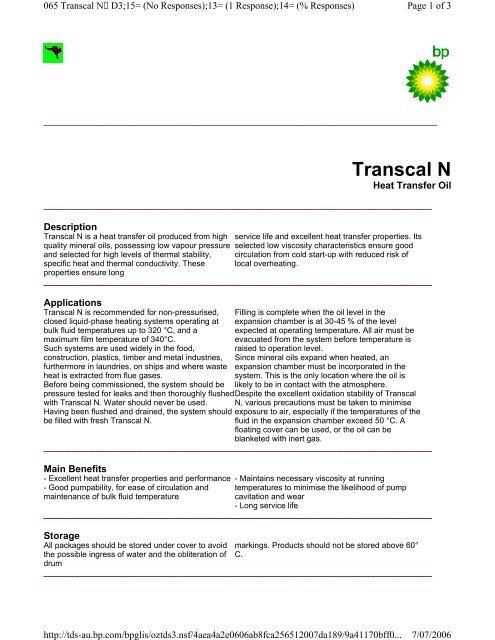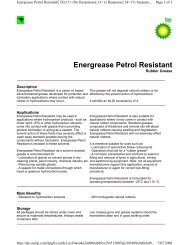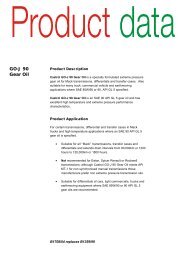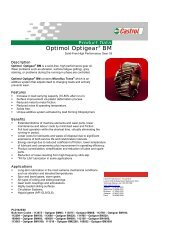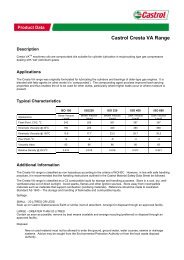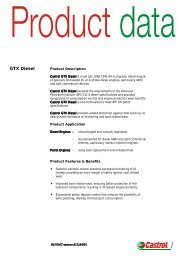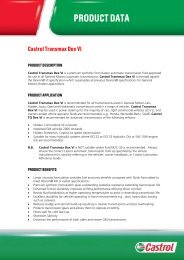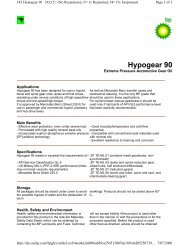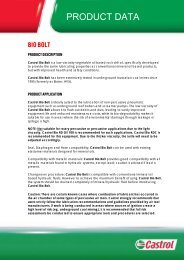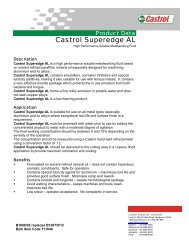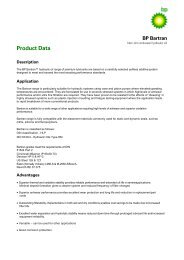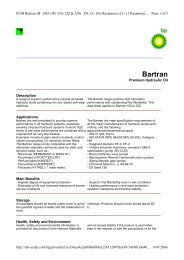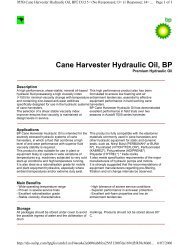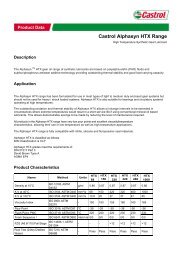Transcal N - Castrol TDS
Transcal N - Castrol TDS
Transcal N - Castrol TDS
You also want an ePaper? Increase the reach of your titles
YUMPU automatically turns print PDFs into web optimized ePapers that Google loves.
065 <strong>Transcal</strong> N<br />
D3;15= (No Responses);13= (1 Response);14= (% Responses)<br />
http://tds-au.bp.com/bpglis/oztds3.nsf/4aea4a2e0606ab8fca256512007da189/9a41170bff0...<br />
Page 1 of 3<br />
7/07/2006<br />
_________________________________________________________________________________<br />
<strong>Transcal</strong> N<br />
Heat Transfer Oil<br />
________________________________________________________________________________<br />
Description<br />
<strong>Transcal</strong> N is a heat transfer oil produced from high service life and excellent heat transfer properties. Its<br />
quality mineral oils, possessing low vapour pressure selected low viscosity characteristics ensure good<br />
and selected for high levels of thermal stability, circulation from cold start-up with reduced risk of<br />
specific heat and thermal conductivity. These local overheating.<br />
properties ensure long<br />
________________________________________________________________________________<br />
Applications<br />
<strong>Transcal</strong> N is recommended for non-pressurised,<br />
closed liquid-phase heating systems operating at<br />
bulk fluid temperatures up to 320 °C, and a<br />
maximum film temperature of 340°C.<br />
Such systems are used widely in the food,<br />
construction, plastics, timber and metal industries,<br />
furthermore in laundries, on ships and where waste<br />
heat is extracted from flue gases.<br />
Before being commissioned, the system should be<br />
pressure tested for leaks and then thoroughly flushed<br />
with <strong>Transcal</strong> N. Water should never be used.<br />
Having been flushed and drained, the system should<br />
be filled with fresh <strong>Transcal</strong> N.<br />
Main Benefits<br />
Storage<br />
Filling is complete when the oil level in the<br />
expansion chamber is at 30-45 % of the level<br />
expected at operating temperature. All air must be<br />
evacuated from the system before temperature is<br />
raised to operation level.<br />
Since mineral oils expand when heated, an<br />
expansion chamber must be incorporated in the<br />
system. This is the only location where the oil is<br />
likely to be in contact with the atmosphere.<br />
Despite the excellent oxidation stability of <strong>Transcal</strong><br />
N, various precautions must be taken to minimise<br />
exposure to air, especially if the temperatures of the<br />
fluid in the expansion chamber exceed 50 °C. A<br />
floating cover can be used, or the oil can be<br />
blanketed with inert gas.<br />
________________________________________________________________________________<br />
- Excellent heat transfer properties and performance - Maintains necessary viscosity at running<br />
- Good pumpability, for ease of circulation and temperatures to minimise the likelihood of pump<br />
maintenance of bulk fluid temperature<br />
cavitation and wear<br />
- Long service life<br />
________________________________________________________________________________<br />
All packages should be stored under cover to avoid markings. Products should not be stored above 60°<br />
the possible ingress of water and the obliteration of C.<br />
drum<br />
________________________________________________________________________________
065 <strong>Transcal</strong> N<br />
D3;15= (No Responses);13= (1 Response);14= (% Responses)<br />
http://tds-au.bp.com/bpglis/oztds3.nsf/4aea4a2e0606ab8fca256512007da189/9a41170bff0...<br />
Page 2 of 3<br />
7/07/2006<br />
Health, Safety and Environment<br />
Health, safety and environmental information is<br />
provided for this product in the relevant Materials<br />
Safety Data Sheet, which can be obtained by<br />
contacting the BP Lubricants and Fuels Technical<br />
Helpline on 1300 139 700. BP Australia, or its<br />
subsidiaries<br />
will not accept liability if the product is used other<br />
than in the manner or with the precautions or for the<br />
purpose/s specified. Before the product is used<br />
other than as directed, advice should be obtained<br />
from the local BP office or Lubricants and Fuels<br />
Technical Helpline.<br />
________________________________________________________________________________<br />
<strong>Transcal</strong> N<br />
Heat Transfer Oil<br />
________________________________________________________________________________<br />
Typical Characteristics<br />
Grade:<br />
Mnemonic:<br />
<strong>Transcal</strong> N<br />
TCALN<br />
Product Code: 230339<br />
Test Method<br />
Units<br />
Density at 15°C ASTM D1298 kg/L 0.875<br />
Flash Point (PMC) ASTM D93 °C 210<br />
Flash Point (COC) ASTM D92 °C 221<br />
Fire Point ASTM D92 °C 243<br />
Autogenous Ignition temp. ASTM D2155 °C 350<br />
Kinematic viscosity<br />
@ 40 °C ASTM D455 cSt 31<br />
@ 100 °C ASTM D455 cSt 5.2<br />
Pour point ASTM D97 °C -12<br />
Neutralisation Value ASTM D974 mgKOH/g
065 <strong>Transcal</strong> N<br />
D3;15= (No Responses);13= (1 Response);14= (% Responses)<br />
http://tds-au.bp.com/bpglis/oztds3.nsf/4aea4a2e0606ab8fca256512007da189/9a41170bff0...<br />
Page 3 of 3<br />
7/07/2006<br />
Coefficient of Thermal 0.00077<br />
Expansion (per °C)<br />
Normal Operating Temperature<br />
°C -10 to 320<br />
Range of Bulk Oil<br />
________________________________________________________________________________<br />
The above figures are typical of those obtained with normal production tolerance and do not constitute a<br />
specification.<br />
Note : The terms 'Flash Point' and 'Fire Point' in the typical characteristics table are purely technical names<br />
covering specific tests : they are not directly related to any hazard from spontaneous combustion or explosion. In<br />
a heat-transfer system it is quite normal for the oil temperature to be higher than its flash and fire point.<br />
This Data Sheet and information it contains is considered to be<br />
accurate at the date of printing. No warranty or representation,<br />
expressed or implied, is made as to the accuracy or completeness of<br />
the data and information contained in this publication.<br />
It is the User's obligation to evaluate and use products safely and<br />
within the scope advised in the data sheet and to comply with all<br />
applicable laws and regulations. No statement made in this publication<br />
shall be construed as a permission, recommendation or authorisation<br />
given or implied to practice any patented invention without a valid<br />
licence.<br />
The Seller shall not be responsible for any loss or damage resulting<br />
from any hazards or risks identified in the data sheet and which are<br />
associated with petroleum products concerned (provided that this<br />
disclaimer shall not affect any statutory rights of the Buyer of the<br />
petroleum products concerned).<br />
BP Australia Pty Ltd Lubes & Fuels Tech. Helpline: 1300 139 700<br />
Melbourne Central Tower Fax (Australia): (03) 9268 4394<br />
360 Elizabeth Street<br />
Melbourne Victoria 3000<br />
ABN 53004 085 616<br />
© BP Oil International Ltd.<br />
aus9503 16282<br />
________________________________________________________________________________<br />
_________________________________________________________________________________<br />
Last Modified: 05/09/2003 00:15:35<br />
_________________________________________________________________________________


